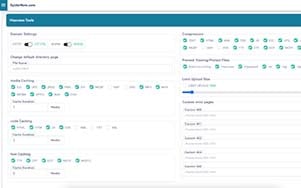Understanding Total Blocking Time
To understand TBT, it's essential to grasp the concept of the main thread. The main thread is responsible for executing JavaScript, rendering the page, and handling user input. Any blocking tasks on the main thread can delay user interactions and make the website feel unresponsive.
Total Blocking Time is calculated by summing up all the individual blocking times that occur during page load. These blocking times are caused by long JavaScript tasks, heavy rendering, or other activities that prevent the main thread from responding to user input.
Understanding TBT helps you identify the factors contributing to poor performance and take appropriate measures to optimize it. By reducing TBT, you can improve the loading speed and responsiveness of your website, resulting in a better user experience.
What is Total Blocking Time (TBT) in the context of website performance?
Total Blocking Time (TBT) is a metric that measures the total amount of time during which the main thread of a webpage is blocked and unable to respond to user input, such as clicks, scrolls, and keyboard interactions. It is a key indicator of a webpage's responsiveness and user interactivity, directly impacting the overall user experience.
The Impact of Total Blocking Time on Website Performance
Total Blocking Time has a direct impact on website performance and user experience. When TBT is high, users may experience delays when interacting with the page, leading to frustration and dissatisfaction.
Additionally, TBT plays a crucial role in search engine optimization (SEO). Search engines like Google consider page speed and user experience as ranking factors. Websites with high TBT may receive lower rankings, resulting in reduced organic traffic and visibility.
By optimizing TBT and reducing blocking time, you can improve website performance, enhance user satisfaction, and potentially boost your search engine rankings.
How does Total Blocking Time impact website analytics?
Total Blocking Time impacts website analytics in several ways:
1. User Behavior: High TBTs can lead to lower engagement metrics such as time on page, pages per session, and conversion rates, as users may abandon slow-loading pages before fully interacting with them.
2. Bounce Rates: Pages with long TBTs often have higher bounce rates, as users are more likely to leave the website if they experience delays or unresponsiveness during the loading process.
3. Conversion Tracking: Analyzing TBT alongside other performance metrics allows you to identify performance bottlenecks and optimize your website for better user experience and conversion rates.
How does Total Blocking Time impact search engine rankings?
Total Blocking Time can impact search engine rankings indirectly through its influence on user experience and page speed metrics:
1. User Experience Signals: Search engines prioritize websites that provide a positive user experience, including fast loading times and responsiveness. High TBTs can lead to lower engagement metrics and higher bounce rates, signaling to search engines that the website may provide a poor user experience.
2. Page Speed: TBT is a component of core web vitals and other page speed metrics that are considered ranking factors by search engines. Websites with fast loading times and low TBTs are more likely to rank higher in search engine results pages (SERPs) than those with slow loading times and high TBTs.
Optimizing Total Blocking Time: Best Practices
To optimize TBT, there are several best practices you can follow:
- Minimize and defer JavaScript: Reduce the amount of JavaScript code and defer non-critical scripts to improve page loading speed.
- Optimize rendering: Use browser caching, optimize images, and leverage techniques like lazy loading to improve rendering performance.
- Use web workers: Offload heavy JavaScript tasks to web workers to prevent them from blocking the main thread.
- Prioritize critical resources: Load critical resources first to ensure a fast and responsive user experience.
- Reduce third-party scripts: Evaluate the necessity of third-party scripts and eliminate or minimize their usage to reduce TBT.
By implementing these best practices, you can significantly reduce TBT and enhance your website's performance.
Tools and Techniques for Improving Total Blocking Time
There are various tools and techniques available to improve TBT:
- Chrome DevTools Performance panel: Use the Performance panel to analyze TBT and identify blocking tasks.
- Lighthouse: Lighthouse is an open-source tool that provides audits and recommendations for improving website performance, including TBT optimization.
- WebPageTest: WebPageTest allows you to test your website's performance and provides insights into TBT and other performance metrics.
- PageSpeed Insights: PageSpeed Insights analyzes your website's performance and provides suggestions for improving TBT and other performance aspects.
- Code optimizations: Perform code optimizations such as removing unused code, minifying JavaScript, and optimizing CSS to reduce TBT.
By utilizing these tools and techniques, you can effectively improve TBT and boost your website's performance.










